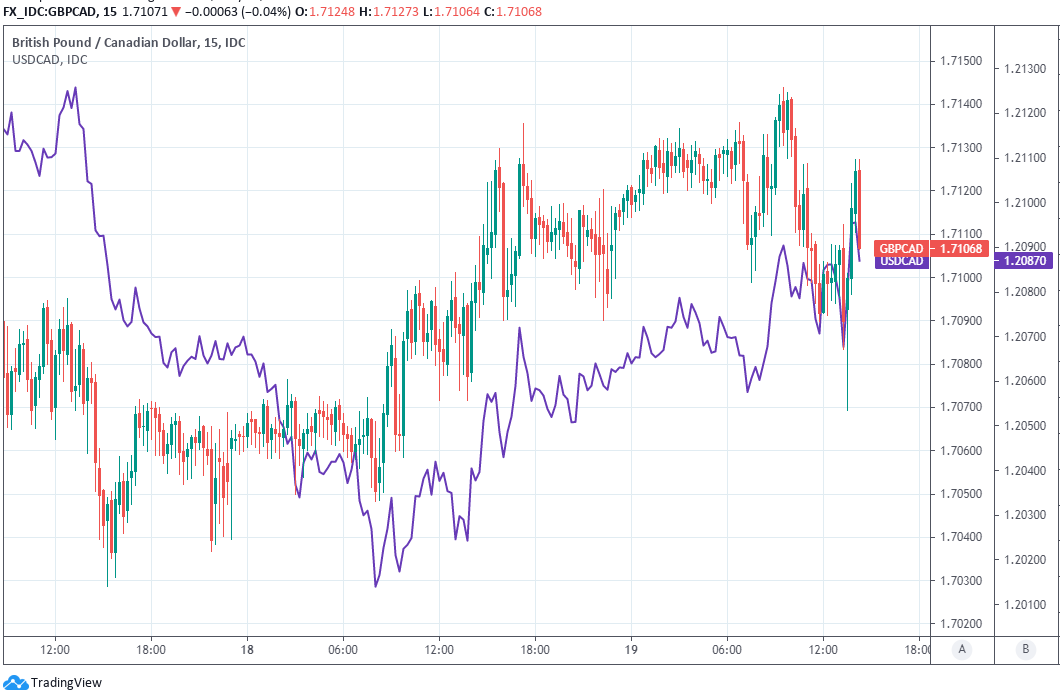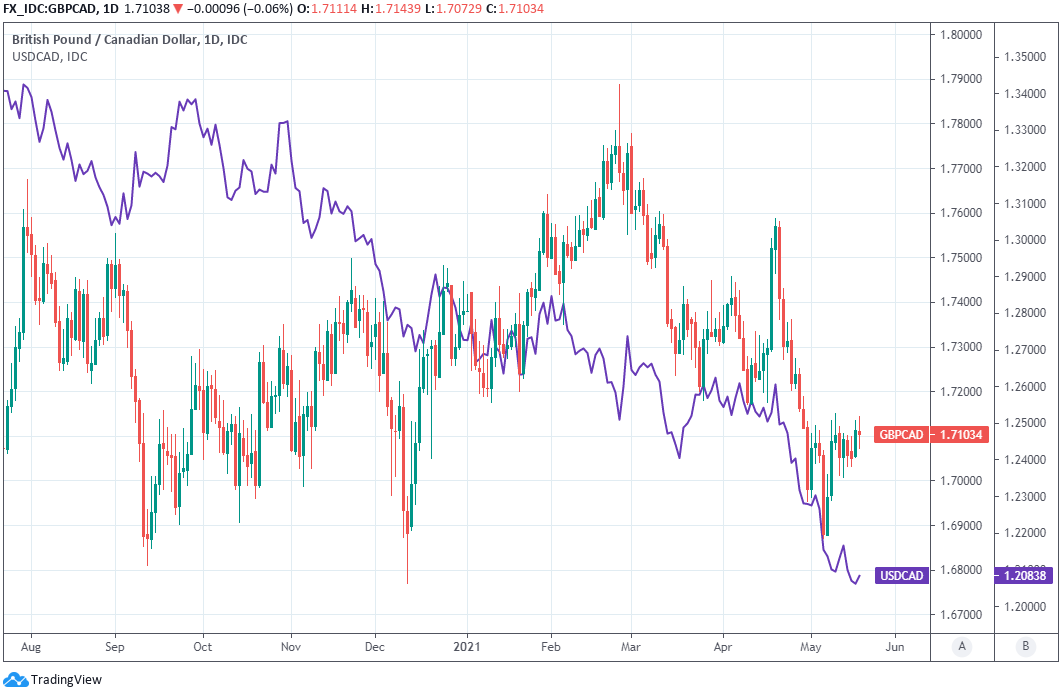Canadian Dollar Stalls after "Base Effects" Cited for Inflation Surge
- Written by: James Skinner
-
- USD/CAD, GBP/CAD advance despite Canadian inflation surge
- CPI rises 3.4%, ex-energy up 1.6% with “base effects” cited
- CPI declines in 2020 threaten further inflation strength ahead

Image © Adobe Stock
- GBP/CAD reference rates at publication:
- Spot: 1.7116
- Bank transfer rates (indicative guide): 1.6520-1.6640
- Money transfer specialist rates (indicative): 1.6727-1.6700
- More information on securing specialist rates, here
- Set up an exchange rate alert, here
The Canadian Dollar had outperformed in the midweek session but softened after statistical base effects were cited by Statistics Canada for inflation that surged even further above the Bank of Canada target in April, enabling USD/CAD and GBP/CAD to rise tepidly off session lows.
Canadian inflation rose by 0.5% for a second consecutive month in April, faster than the 0.2% anticipated by consensus and enough to lift the annualised rate of price growth from 2.3% to 3.4% and its highest in the decade since 2011.
“A significant proportion of this increase was attributable to a steep decline in prices in April 2020,” said Statistics Canada, referring to the country's first full month of ‘lockdown’ and also Canada’s first instance of sub zero inflation for a decade too.
The single largest contributor to inflation last month was a 62.5% increase in the price of gasoline resulting from volatility in underlying oil markets and the shutdowns that spread across the world along with the coronavirus in April last year.
Excluding changes in energy prices, inflation was a more tame 1.6% last month and still comfortably below the 2% target of the Bank of Canada, which is seeking confidence that inflation will not only reach 2% but hold around there over the medium-term before lifting the cash rate from its 0.25% record low.
“The Bank of Canada's three core measures were also up a bit more than expected. The central bank will likely try to look through this, with the labour market still a long way from full employment. But that may only be a temporary solution, if price pressures prove more persistent,” says Royce Mendes, an economist at CIBC Capital Markets.
“Yields are higher in Canada following the release,” he adds.
Above: Pound-to-Canadian Dollar rate shown at 15-minute intervals with USD/CAD.
Secure a retail exchange rate that is between 3-5% stronger than offered by leading banks, learn more.
Canada’s Dollar had been an outperformer before the data was released, holding steady against the U.S. greenback and edging higher relative to Sterling although both USD/CAD and the Pound-to-Canadian Dollar rate climbed from session lows after.
“Somewhat softer commodity prices certainly represent a headwind for the CAD but we note that CAD-supportive spreads are little changed and should serve to limit losses. Our fair value estimate for USDCAD remains below 1.20 this morning. We still favour looking to fade minor USD gains,” says Shaun Osborne, chief FX strategist at Scotiabank.
Economists, analysts and financial markets have been on edge in recent months, fearing that a combination of pandemic-inspired monetary policies and goods supply chain hold ups would lead to runaway inflation which then see central banks feeling compelled to lift interest rates or tighten other policies in response.
{wbamp-hide start} {wbamp-hide end}{wbamp-show start}{wbamp-show end}
Some of those anticipated moves would be positive short-term influences on the currencies concerned so worries about inflation, or speculation on runaway price growth could explain the Canadian Dollar’s earlier outperformance on Wednesday, especially in light of recent Bank of Canada guidance.
"We take this as a sign that the FX market likely still has USDCAD to sell, which makes pullbacks in the downtrend smaller than they would be in a balanced market. The lack of CAD downside may also reflect market nervousness about today's Canadian CPI number,” says Greg Anderson, Global Head of FX Strategy at BMO Capital Markets referring to the Loonie’s comparative resilience in a note ahead of the data.
The BoC pared back its quantitative easing programme for a second time in April and indicated for the first that Canada’s economy could be in a position to sustainably deliver the 2% inflation target by the middle of next year, which implies there are some circumstances in which an interest rate rise could come around then.
Above: Pound-to-Canadian Dollar rate shown at daily intervals with USD/CAD.
To the extent that this does explain the Loonie’s earlier outperformance, Statistics Canada’s prominent citation of “base effects” for April price gains may help to explain the market’s response.
“We think that recent inflation surprises are not evidence of a regime shift in price setting behaviour. But the path for inflation over the next few months is highly uncertain and depends on several difficult-to-predict factors, ensuring that every development will be intensely scrutinised,” says Ben May, director of global macro research at Oxford Economics.
“Surging demand for goods along with major supply chain issues are likely to lead to further goods price rises even as spending patterns begin to shift back to pre-crisis norms. It will probably take several more months for freight bottlenecks and semiconductor shortages to be resolved.”
Central banks have mostly dismissed these market concerns as overdone, drawing in the process on a decades long trend in which central bank policymakers have mostly struggled to lift measures of consumer price growth up to the levels set as policy targets.
The above reflects an inflation deficit, the cause of which remains a matter of hotly contested debate among academics, financial professionals and policymakers although in light of it many central banks remain highly sceptical of suggestions that inflation could suddenly make an uncontrollable comeback.











